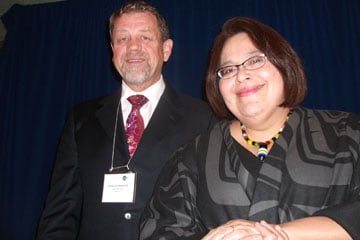
Stereotyping and discrimination exists within the British Columbia legal community as lawyers attending the Law Society of B.C.'s Truth and Reconciliation symposium Nov. 23 heard from indigenous lawyers who have been mistaken in court for the accused, and who faced barriers getting access to court resources.

Stereotyping and discrimination exists within the British Columbia legal community as lawyers attending the Law Society of B.C.'s Truth and Reconciliation symposium Nov. 23 heard from indigenous lawyers who have been mistaken in court for the accused, and who faced barriers getting access to court resources.
Law Society of B.C. president Herman van Ommen calls the stories "shocking and horrible."
"It is unacceptable for them to have to experience this," says van Ommen, who co-chaired the day-long event with Ardith Walpetko We'daix Walkem, a Chilliwack indigenous lawyer and member of the LSBC's Truth and Reconciliation Advisory Committee.
Stories of how native lawyers were treated were contained in a short video called "But, I Was Wearing a Suit" produced by a group of indigenous lawyers with the support of the Continuing Legal Education Society of B.C., a co-sponsor of the symposium, plus the LSBC. The video can be viewed on both the CLEBC website and on YouTube.
The stories sent a powerful message regarding how the justice system and legal profession views indigenous people, the conference heard. Van Ommen says it is important to hear the stories to effect change, but also effect change that is important to indigenous people. He says the symposium was an opportunity to "listen and learn" so that the LSBC could take the necessary steps to move in the right direction.
He says the LSBC work is ongoing as elements of the Truth and Reconciliation Commission report are being integrated into the LSBC's strategic plan, it continues collaboration with the aboriginal community, and plans more initiatives in 2018.
Walkem says it was important to remember that the TRC findings grew out of the class action suit over the residential schools and was a call to begin to repair society and also a healing process within the Indigenous community based upon truths. The laws in the past were used as a powerful tool to repress Aboriginal people. She says the power of the legal community can also be used to facilitate a healing and repairing process.
"One of the things the legal profession can do is re-think and redo the way we practice law and how we approach law," she says.
Keynote speaker Judge Steven L. Point, a former Lieutenant Governor of B.C., told the 300 attending the conference and another 150 who were online that indigenous people bring a different perspective to law. In law, he says, there is always the "reasonable man" test when decisions have to be made but that test was really "what would the reasonable white man do.”
"No one asked what the reasonable aboriginal would do," he says. That failure to ask the question is why the judicial, education and health care system has not worked for the indigenous people, he says.
Point says the indigenous perspective is rooted in their territorial lands, culture and the spiritual beliefs that pertain to both and that perspective differs from the economic decisions that drive society today. "I think the aboriginal perspective has significant value because it balances that which occurs in the boardroom,” he says.
In a break-out session, Dr. Bruce McIvor, who described himself as a "cause" lawyer handling Indigenous clients, says there were many systemic biases throughout colonial laws which have undermined indigenous laws including how indigenous people identified themselves.
Indigenous people self-identified by belonging to a certain group or area, but federal government statutes now label or exclude indigenous people. The Indian Act including the 1985 Bill-C amendment labelled who is deemed a status Indian. While the amendment was intended to repatriate the rights of Indian women who married non-natives, it recreated two classes of women: known as 6.1 (two native parents) and 6.2 (one native parent). Only those in 6.1 can pass on their native status unless a 6.2 woman married someone who was a status Indian. The Canadian Constitution Act s. 35 recognizes treaty rights and aboriginal people of Canada as Indian, Inuit and Métis.
McIvor says there are many indigenous people who are not considered status. The difficulty comes when an indigenous member (who may not be a status Indian under the act) exercises his treaty rights such as hunting or fishing and is stopped by enforcement officers seeking a status card. "The lack of a status card can limit those rights," he says.
An indigenous symposium member attending the session says: "It is dangerous to let others define who we are."
McIvor says there was a role to play for the legal profession in ensuring that statutes did not limit the treaty rights or the identity of indigenous people. He says he believes that indigenous people will define themselves. "Eventually, we will get there," he says.
West Coast Environmental Law's Maxine Matilpi, chairing a session on the co-existence of indigenous and Canadian law, described a 2016-initiated project RELAW (Revitalizing Indigenous Law for Land, Air and Water). The West Coast Environmental Law project is supported and advised by the Faculty of Law's Indigenous Law Research Unit at the University of Victoria.
Matilpi says the initiative involves drawing out principles of law from indigenous stories that relate to natural elements in such as water, air, and land. "We take these stories very seriously," she says, adding that they can variety from area to area but form a basis for how Indigenous people viewed natural resource law.
She says that in 2018, the University of Victoria will be offering a new four-year law degree that not only common law but also Indigenous law.
The CLEBC is also hosting a two-day conference April 28 and 27, 2018 at the Pan Pacific Hotel in Vancouver on Indigenous Laws.